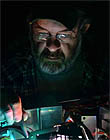|
|
This topic comprises 2 pages: 1 2
|
|
Author
|
Topic: Silver screens
|
|
|
|
|
|
|
|
|
|
|
Stephen Furley
Film God

Posts: 3059
From: Coulsdon, Croydon, England
Registered: May 2002
|
 posted 05-25-2009 03:57 AM
posted 05-25-2009 03:57 AM




This page from the Widescreen Museum:
web page
which seems to be taken from original material published at the time says that they are
'not simply sheets of fabric sprayed with aluminum or other reflecting materials, but they have been embossed with tiny elements, each one of which is so shaped as to reflect light toward the seats in a theatre and to keep it out of waste spaces.'
Of course, 'Not simply' does not mean that they were not silver. However, further down the page it says that these screens are suitable for 3-D. It doesn't say what type of 3-D, but for film, at that time, two strip polarised was the norm, so this seems to indicate that the screens were silver, in addition to the 'millions of tiny "lenses"'. I do remember on an old one which I saw that the joins in the screen showed up badly, and the surface was also badly marked, but it would have been about fifteen years old at the time.
Interesting that it says this:
'20th Century-Fox CinemaScope attractions are available to any exhibitor who can provide a satisfactory projection on whatever screen used.'
I though that the Miracle Mirror, along with the stereophonic sound system was mandatory for Cinemascope. There's no date on this page, maybe it was mandatory at first, but Fox later dropped this requirement, even before they dropped the requirement for stereophonic sound.
| IP: Logged
|
|
Julio Roberto
Jedi Master Film Handler
Posts: 938
From: Madrid, Madrid, Spain
Registered: Oct 2008
|
 posted 05-25-2009 08:22 AM
posted 05-25-2009 08:22 AM



What is being described is what is commonly known as "lenticular" in these situations.
Instead of spray-painting aluminum flakes onto a flat matte white surface to make it "silver", a pattern is embossed into either the substrate or the actual surface.
The silver surface is generally very reflective, and thus offers too much gain to the front, meaning too little (negative) gain to the sides.
The pattern that makes sense to help with this problem is a lenticular one, where the surface is shapped like little (thin) waves running vertically. We don't care about the lack of angle of view vertically, only horizontally, as nobody is looking at the screen from above and the height is usually small compared to the width.
This helps spread light more evenly horizontally across the surface of the screen, helping a bit with the hotspot, the dark corners and the small angle of view. More help can be obtained by curving the screen a bit as well.
Some of the current silver screens are also manufactured of a lenticular kind.
Traditionally, all 3D systems in use in cinema required a silver screen. Exceptions are, of course, the very seldom used Anaglyph systems (i.e. color red/blue glasses) and, much more recently, active glasses systems (some Imax Solido and XpanD) and Dolby (Infitec).
Silver screens were also used for non-3D applications in theaters that wanted to boost the (apparent) light output thanks to the enormous gain they offered. Since the first anamorphic lenses probably sucked up a bit of light, I can see an use in those situations as well.
Due to the reflectivity and inherent color spectrum etc, images usually look very contrasty and saturated (except in the corners if the screen is large, lol), so those could be desirable features to some as well. I'm not going to point out the "not so desirable" features of silver screens .... lenticular or not ... curved or not ...
But for 3D, they were almost mandatory for the longest time. Still are.
| IP: Logged
|
|
|
|
|
|
|
|
|
|
|
|
|
|
|
|
|
|
|
|
All times are Central (GMT -6:00)
|
This topic comprises 2 pages: 1 2
|
Powered by Infopop Corporation
UBB.classicTM
6.3.1.2
The Film-Tech Forums are designed for various members related to the cinema industry to express their opinions, viewpoints and testimonials on various products, services and events based upon speculation, personal knowledge and factual information through use, therefore all views represented here allow no liability upon the publishers of this web site and the owners of said views assume no liability for any ill will resulting from these postings. The posts made here are for educational as well as entertainment purposes and as such anyone viewing this portion of the website must accept these views as statements of the author of that opinion
and agrees to release the authors from any and all liability.
|

 Home
Home
 Products
Products
 Store
Store
 Forum
Forum
 Warehouse
Warehouse
 Contact Us
Contact Us




 Printer-friendly view of this topic
Printer-friendly view of this topic








![[Big Grin]](biggrin.gif)


![[Roll Eyes]](rolleyes.gif)






